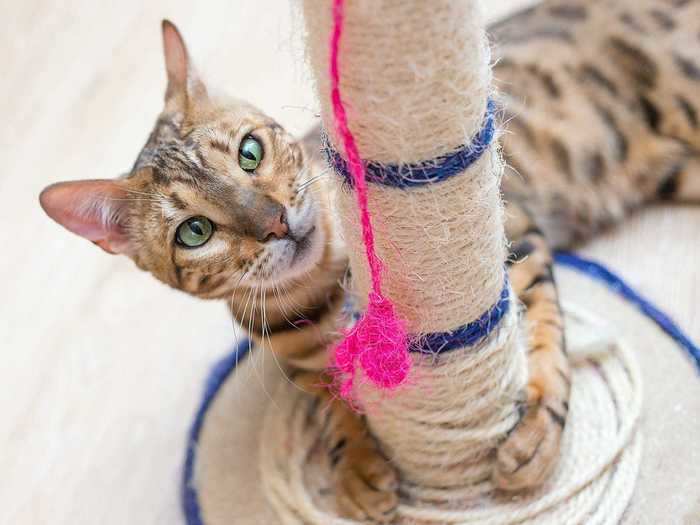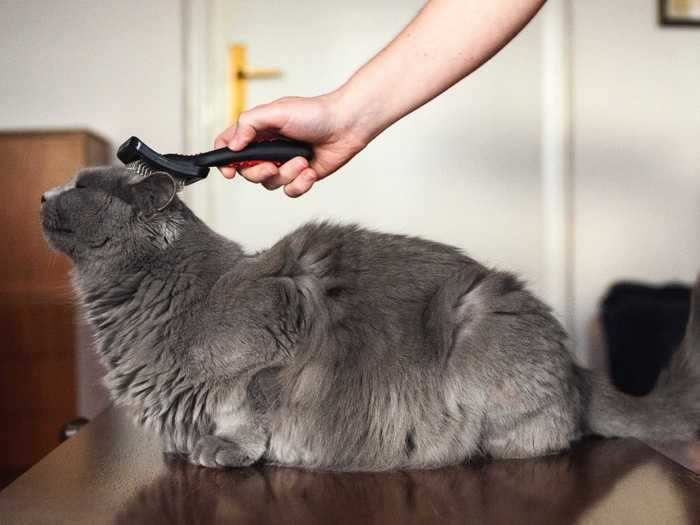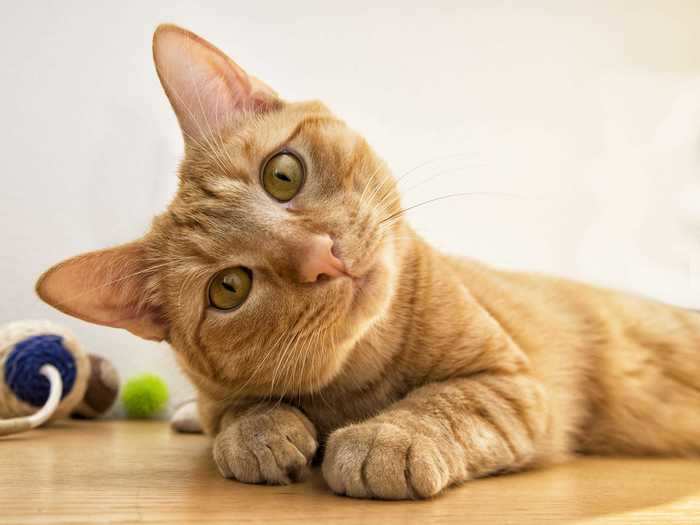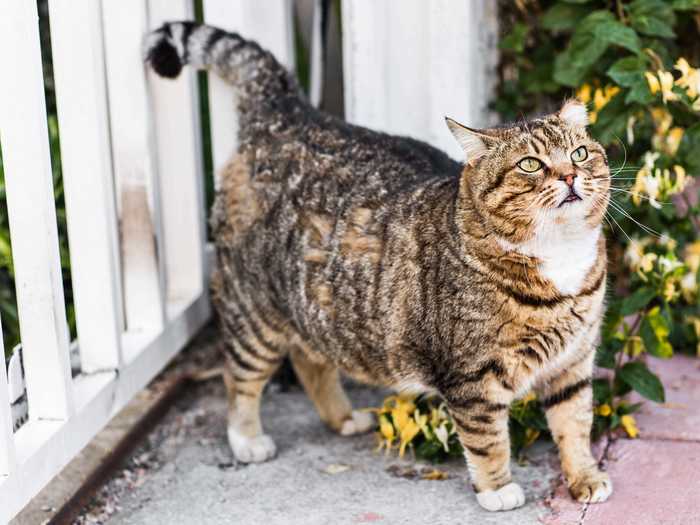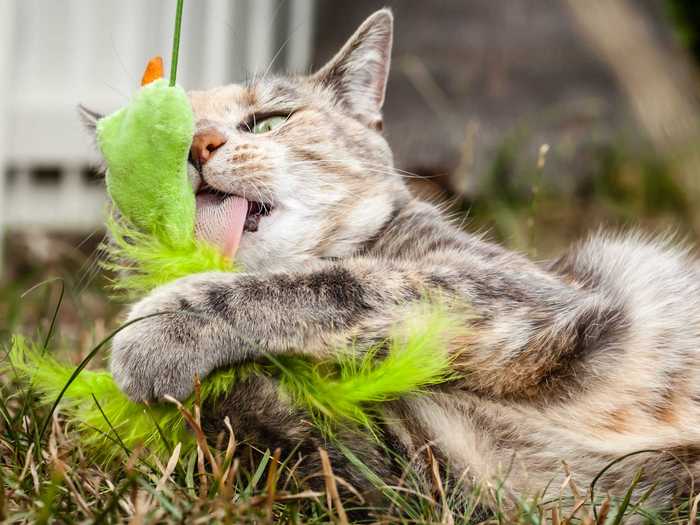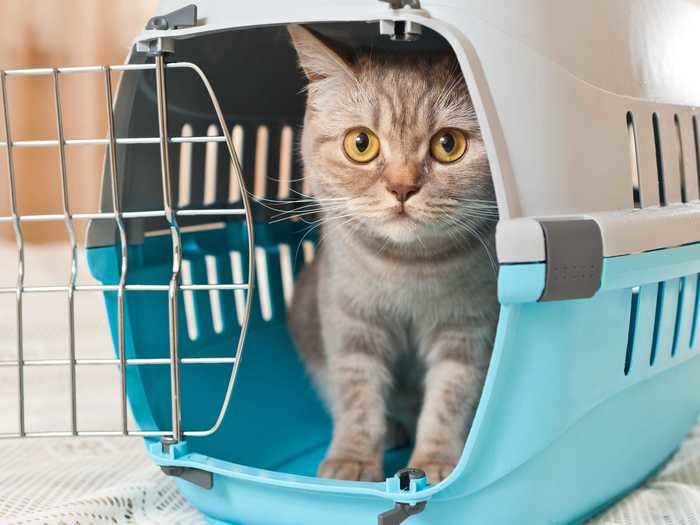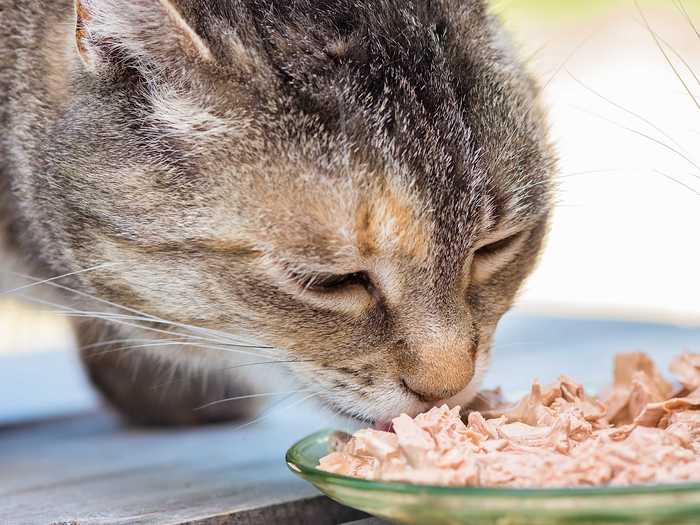If your cat is keeping you up all night, you may want to try tiring them out before bedtime with some toys.Shutterstock
- Insider spoke with vets about how to solve common problems cat owners may face.
- Getting a heavier scratching post may stop your cat from tearing up the furniture.
- If your cat isn't using their litter box, try moving it to a new location or trying a different style of box.
- If you feel your pet is acting strangely, you may want to have them checked by a vet as some common cat problems can be attributed to an underlying medical issue.
Keeping your cat happy and healthy isn't always straightforward, especially when your feline friend starts behaving in unusual ways.
Insider spoke with veterinarians to find out their solutions to the most common problems that cat owners face.
Here's how to deal with everything from hairballs to accidents outside of the litter box.
You may be able to stop your cat from tearing up furniture by getting them a heavier scratching post.
Cats will often be more likely to use a scratching post if it's sturdy.
iStock / Getty Images Plus/ Anna Volgina
If your cat likes to tear up the furniture — even when there's a perfectly good scratching post nearby — the problem may be a wobbly post.
"Vertical scratching posts tend to be top-heavy and will often move when your cat begins to scratch," Molly Farrell, veterinarian and owner of Dyer Animal Clinic, told Insider. "They don't like this and will find a heavier object, such as your furniture, to use as their post."
Farrell said she recommends opting for a heavier or horizontal post, especially one infused with pheromones that attract cats.
When the cat attempts to scratch your furniture, Farrell explained, you need to let them know that the furniture is off-limits.
"After distracting them, you can calmly move your cat to the scratching post to help them understand that the post is for scratching," she said.
If your cat is getting hairballs, they may need to be combed more often.
Long-haired cats required more brushing than short-haired ones.
Getty/Royalty-free/cunfek
Cats groom themselves often, which can occasionally lead to balls of fur building up in their stomach from the fur they swallow. These clumps of hair usually pass through their stool, but cats sometimes vomit them instead.
"Daily combing will help in minimizing the amount of fur the cat will ingest," said Farrell, who added that long-haired breeds should be brushed more frequently to remove excess fur.
If this is a persistent issue, you can also ask your vet about trying an over-the-counter hairball treatment for your cats.
That said, frequent vomiting or gagging may be indicative of a health problem, so talk to your vet if you notice more than the occasional hairball from your pet.
Changing your bedtime routine may help prevent your cat from waking you up at night.
Some cats are most active at night.
Shutterstock
Leslie Brooks, veterinarian and advisor for Betterpet, told Insider that if your pet is a night owl, you should "try to tire your cat out right before bedtime to decrease nighttime activity."
Your cat could also be yowling at night because they're hungry.
If that's the case, Farrell said, you should "try leaving some canned food out overnight for a couple of weeks to see if this makes a difference."
She also noted that some medical conditions, such as arthritis or thyroid issues, may cause cats to whine or move around a lot during the night. Check with your vet if you have any concerns.
If your cat isn't using their litter box, you may have to relocate it.
If your cat isn't using their litter box, you may need to replace it with a different style of box.
iStock
There are a few ways to troubleshoot if your cat is going to the bathroom outside of their litter box.
"Try getting a larger litter box with higher sides for privacy, because some cats don't like to squat," said Farrell. "You should also have at least one litter box per cat, as dominant cats can scare others from using the box."
Where you place the litter box in your home is also important.
"Don't place litter boxes near washing machines, dryers, furnaces, or other loud appliances," Farrell told Insider. "These noises startle the cat and they are more likely to avoid the area where the litter pans are located."
Frequent accidents may also be caused by a health issue, such as a urinary blockage or kidney infection. If your cat is struggling to use the litter box, you may want to speak to your vet to rule out potential health problems.
If your cat is bringing you unwanted dead animal "presents," try limiting their outdoor time.
You may want to check your cat's mouth before letting them indoors.
Shutterstock
Hunting is a normal cat behavior. Unfortunately, this feline instinct can result in some grisly gifts, such as dead mice or birds, in your home.
"Since you feed them, your cat no longer has to hunt for nutrition. Instead, they bring you dead animals to show you how much they love you and as service to you," Brooks explained.
Unfortunately, there's not much you can do about this particular habit other than limiting your cat's access to live prey.
"You can try to prevent your cat from going outdoors," Brooks told Insider. "And before allowing your cat back into the house, meet them outside and make sure they don't have any 'presents' in their mouth."
If your cat is scratching you or biting you, you might want to rethink how you play with them.
When playing with a cat, don't use your fingers or hands as toys.
Shutterstock
Cats have sharp claws that can easily scratch skin and clothing — fortunately, tweaking the way you play can help teach your pet not to scratch people.
"Do not use your fingers, hands, or feet to play with cats," said Farrell. "Playing roughly with your cat, like you might with a dog, will only teach it to be aggressive."
Farrell also advised giving a sharp cry when your cat scratches or bites you, then ending the play session.
"This is a notification that the bite is painful, and that the cat needs to stop," said Farrell.
To prevent your cat from whining or begging during mealtimes, don't let them have any human food.
Avoid feeding your cat scraps from your table.
Shutterstock
It can be frustrating when pets whine for food while people are eating, but you can help change their behavior by coordinating mealtimes and resisting the urge to sneak them table scraps.
"Feed the cat at the same time you are having your meal, and never feed your cat from the table," said Farrell.
A very persistent cat may need to be placed in a separate room while human members of the family enjoy their food, she added.
If your cat is aggressive toward other people or pets, you may want to seek out professional treatment.
Sometimes cats act out when they are in pain or feeling anxious.
Shutterstock
A cat who lashes out at humans or other pets can cause stress or even injury to other family members. It's important to have aggressive behavior addressed by a vet.
"First, make sure there isn't a medical reason for your cat's behavior by scheduling an appointment with your vet," said Brooks. "Some cats show aggression because of anxiety or pain."
Brooks said that, in some cases, behavior-modifying medications may be prescribed by a veterinarian or behaviorist.
Constant itching or grooming may be a sign of fleas or allergies.
If your cat is grooming themselves constantly, there may be a more serious health issue at play.
cristinairanzo/Royalty-free Getty Images
A cat with itchy skin will usually excessively groom or scratch themself — and there are a few common causes of frequent itching in cats.
"You should first check your cat for fleas with a flea comb. Cats are constantly grooming themselves and they will eat the fleas, so fleas can be difficult to find without a comb," said Farrell.
Constant scratching and black debris inside the ears can also be a sign of ear mites, Farrell added.
Take your cat to the vet if they have skin sores, hair loss, or scabs. These may be signs of environmental allergies or a more serious medical condition.
A cat who vomits after meals may be eating too fast.
Certain bowls are designed to slow down your cat's eating speed.
iStock

